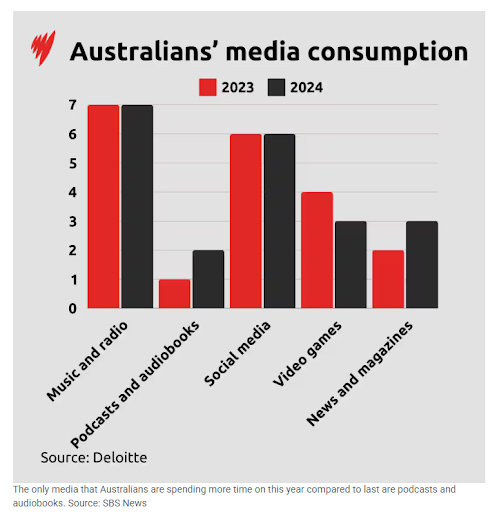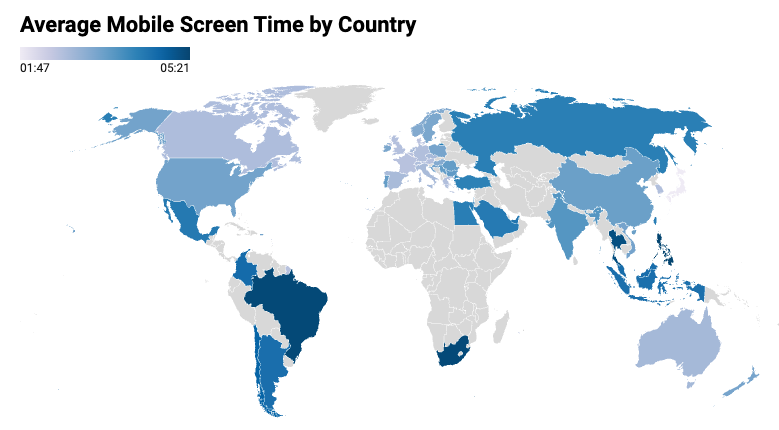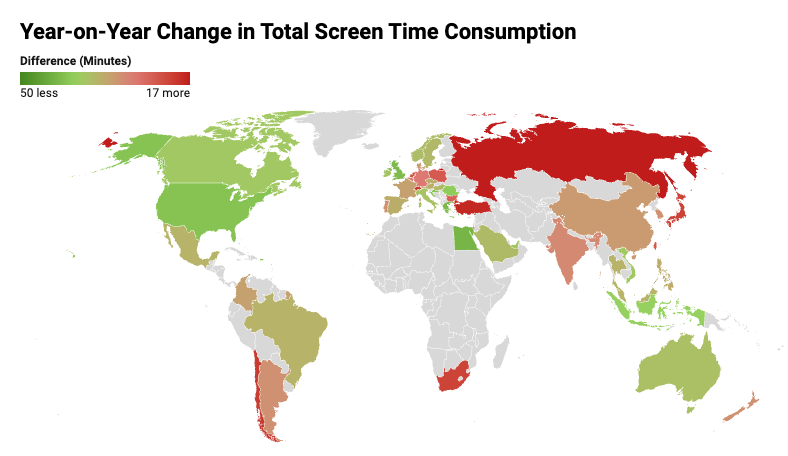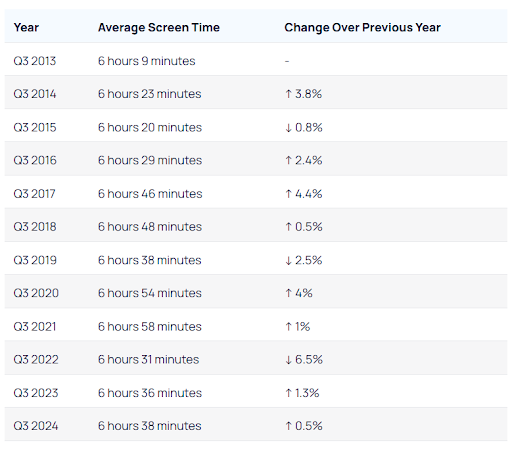
- Red Search
- Resources
- Mobile Phone Screen Time Statistics
Phone Screen Time Statistics Australia & Global (2025)
-
 Daniel Law
Daniel Law
Do you ever catch yourself endlessly scrolling through your phone when you should be working, or find it hard to switch off before bed? While it might initially seem harmless, excessive screen time can gradually impact your health, productivity, relationships, and mental clarity.
Australians are no exception. We spend over six hours a day on our mobile devices. Many of us reach for our phones when we wake up, during our commute, and right before falling asleep.
Even with rising costs, Aussies continue prioritising digital entertainment, maintaining subscriptions to streaming services and other digital platforms. Average household spending on these services has increased by 10% to $63.
In this article, we’ll dive into mobile screen time habits across Australia—what’s driving our digital behaviour, how we compare globally, and the growing effects of prolonged screen exposure. We’ll also explore what Australians are doing to cut back and regain control of their screen use.
How Much Time Do Australians Spend on Their Phones Daily?
- Australians consumed 10% less time on social media and entertainment in 2024 compared to 2023.
- Gen Zs are cutting back on social media usage by a quarter of their weekly time, from 12 hours and 45 minutes a week to 10 hours and 5 minutes a week.
- Three out of four Australians check out social media as soon as they wake up, while four out of five do it before they go to bed.
- According to Peter Corbett, Deloitte’s telecommunications, media, and entertainment partner, there is no longer a peak time for media consumption during the day.
General statistics on mobile phone ownership and usage
- In early 2025, there were 34.4 million active mobile phone connections in Australia, equivalent to 128% of the country’s total population. However, not all these connections had access to the internet.
- 26.1 million individuals used the web in Australia at the start of 2025. Online penetration was at 97.1%
- In January 2025, there were 20.9 million social media user accounts, equivalent to 77.9% of the total population.
- GSMA Intelligence revealed that 100% of connections in Australia may be considered “broadband,” which means they connect through 3G, 4G, or 5G networks.
Mobile Screen Time by Activity Type

Source: SBS News
Australians use their mobile phones for various online activities: listening to music or radio, engaging in social media, watching videos, news and online magazines, and listening to podcasts and audiobooks.
Deloitte revealed the average time Australians spent on these pastimes:
- Music and radio: 7 hours a day
- Social media: 6 hours a day
- Video games: 3 hours a day
- News and magazines: 3 hours a day
- Podcasts and audiobooks: 2 hours a day
Screen Time by Age Group and Gender
Statistics on screen times according to age and gender for Australians are not readily available. However, worldwide statistics describe a grim picture:
- Infants (0 to 2 years): 49 minutes a day
- Children (3 to 12 years): 2.5 to 5 hours a day
- Adolescents (13 to 19 years): 7.5 hours a day
- Adults (20 to 59 years): 6.38 hours a day
- Older Adults (60 and above): 4.6 hours a day.
Regarding gender, females are more likely to use their mobile phones longer than males. A study of more than 30,000 people revealed the following:
- Females spend around 2 hours and 47 minutes on their phones.
- Males spend an average of 2 hours and 34 minutes on their phones.
- 78% of females say they spend more time on their phones than their partners.
- 64% of males claim they spend more time on their phones than their partners.
Global Screen Time: How Does Australia Compare?

Source: Comparitech
A March 2025 Comparitech report on the average mobile screen time by country revealed that Australians spend 2.58 hours daily on mobile phones.
This shows moderate usage of mobile devices compared to other countries.
- Filipinos use mobile phones more than any other country, at 5 hours and 21 minutes daily, a one-minute increase from the country’s 2024 average.
- Brazilians spend 5 hours and 12 minutes daily on their mobile phones, a 7-minute drop from their 2024 average.
- South Africans spend 5 hours and 11 minutes daily on their mobile phones, a 4-minute decline from their 2024 average.
- Americans spend 3 hours and 22 minutes on their mobile phones.
- Canadians spend less time on their mobile phones compared to Australians, at 2 hours and 46 minutes.

From Comparitech’s year-on-year change in total screen consumption time, Australians used their mobile phones for 9 minutes less. Some countries showed great improvements:
- Most countries (27 out of 49) improved their screen times in 2025.
- Hong Kong reduced screen times by 50 minutes (from 6 hours and 19 minutes to 5 hours and 29 minutes!
Meanwhile, other countries have increased screen times:
- 22 countries spent more time on their mobile phones.
- Russians spent 17 minutes more on their mobile phones (from 8 hours and 21 minutes to 8 hours and 38 minutes).
- Turkey spent 16 minutes more (from 6 and 57 minutes to 7 and 13 minutes).
Why are these changes in screen time happening?
Countries showing reduced screen time may be experiencing a continuation of normalcy after the pandemic. People from these countries may be becoming more aware of the negative effects of prolonged screen time on their health.
Also, some mobile phones have digital well-being features encouraging users to check and reduce their screen time.
Screen Time Trends Over Time (2019–2025)
Nowadays, you can access the internet from various devices: smartphones, tablets, desktop computers, laptops, smartwatches, etc. For many, easy accessibility to digital content using different devices has increased screen time.

Source: Exploding Topics
Reports from 2019 to 2024 reveal changing average screen times. In 2019, an average person spent 6 hours to 38 minutes consuming digital content, 2.5% less than the previous year.
Screen times increased by 4% in 2020 when almost everyone was home because of the pandemic. However, as soon as lockdowns were lifted and vaccines were ready, screen times dropped 6.5% in 2022.
The Rise of Screen Time Among Children and Teens
Screen time varies by age, and according to All About Vision, it has increased since the pandemic. The average daily screen times among children and teens are listed below:
- Ages 0 to 2: 49 minutes a day
- Ages 2 to 4: 2 to 2.5 hours a day
- Ages 5 to 8: more than 3 hours a day
- Ages 8 to 12: around 5 hours a day
- Teens: around 7.5 hours a day.
Reasons for the increase in screen time
Technology is a powerful tool to help children communicate, socialise, and learn. However, research suggests that excessive screen time for children and teens negatively affects learning and can lead to emotional and physical problems.
Research reveals an increase in cases of obesity, sleep issues, and mental health conditions among children who are mostly on their phones or mobile devices all day.
Other concerns:
- A 2021 study by the Royal Children’s Hospital in Melbourne found that more than 90% of parents are concerned about their children’s screen time and social media usage. Parents are worried about their kids’ online time, the safety of the internet, and cyberbullying.
- The Gonski report “Growing up Digital in Australia” in 2021 revealed that 78% of teachers saw a decrease in students’ ability to handle learning tasks, 80% saw a decline in empathy, and 60% saw a reduction in physical activity. Increased screen time affects children’s mental and physical abilities and how they experience the world.
- Limiting recreational screen time to less than two hours a day, supporting kids with good sleep, and providing adequate physical activity improve their cognitive abilities and learning capacity.
- Research indicates that excessive screen time and social media exposure may lead to depression and anxiety among young people.
- Children online are constantly exposed to inappropriate and damaging content, such as violence, pornography, sexism, and various extreme views.
Health and Productivity Impacts of High Screen Time
Mobile devices are part of our daily lives. We use our smartphones, laptops, and desktop computers for work and learning.
Our devices help us connect with our loved ones and understand our environment. However, excessive exposure to digital screens can damage health and productivity.
Negative Effects on Health
- Eye strain: Prolonged use of digital screens can harm our eyes, causing dryness, blurred vision, headaches, and pain in the neck and shoulders. Blue light emitted by digital screens can also lead to eye fatigue.
- Poor sleep: Besides eye fatigue, blue light can reduce melatonin production, a hormone that regulates sleep. Using your mobile phone, tablet, or laptop close to bedtime disrupts this process, affecting your circadian rhythm. You can suffer from reduced sleep quality, difficulty falling asleep, and daytime sleepiness.
- Poor dietary habits: When you’re glued to your screens, you might forgo eating or eat more, which can lead to obesity or malnutrition.
- Mental health issues: Excessive screen time increases anxiety and depression among adolescents and young adults. Young people may compare themselves to social media, are exposed to cyberbullying, and may develop the fear of missing out (FOMO).
Negative Effects on Productivity
- Reduced attention spans: Your brain becomes constantly stimulated by digital devices, which may lead to seeking instant gratification and shifts in attention spans. Concentrating on tasks that need focused attention becomes harder, which may affect learning, work, and your everyday life.
- Digital well-being and productivity: Excessive screen time can lead to negative relationships with technology, such as dependence, anxiety when away from mobile devices, and feelings of reduced control. Productivity suffers because of poor focus, fatigue, and reduced cognitive abilities.
How Australians Are Managing Screen Time (Digital Wellbeing Stats)
Australia has recognised the harmful effects of prolonged screen time and social media exposure, especially on children.
In December 2024, the Online Safety Amendment (Social Media Minimum Age) Act 2024 restricts social media access for individuals under 16. This law is expected to take effect in December 2025 and requires the following:
- Social media platforms must take steps to prevent children under 16 from creating accounts. The eSafety Commissioner will issue these steps.
- Applies to age-restricted social media platforms. These platforms are prohibited from disclosing personal information collected from users for age verification and other purposes.
This law aims to protect children and teens from the harmful effects of social media and help reduce screen time.
Screen Time Monitoring Apps
Parents must be proactive in monitoring their children’s screen time using the following strategies:
- Smartphones have built-in features such as “Screen Time” on Apple devices and “Digital Wellbeing” for Android phones. Parents can track screen time by app category and set daily or weekly limits.
- Third-party apps can help monitor screen time. Popular apps in Australia include Kaspersky Safe Kids, Google Family Link, Qustodio, Opal, and Freedom.
- Using grayscale mode on devices can reduce their appeal and minimise screen time. These settings are accessible on iOS and Android phones.
What Does the Future Look Like for Mobile Screen Time?
Based on the following trends, mobile screen time in Australia is likely to grow, although the growth rate may be moderate.
- Smartphone ownership is very high. As of March 2025, 25.64 million Australians own a smartphone.
- Mobile devices are becoming more engaging for Australians because of faster internet speeds (eg. Australian NBN) and more sophisticated apps.
- Younger generations rely heavily on mobile devices for communication, entertainment, and education.
- Wearable devices are now more sophisticated and are integrated with smartphones.
However, growing awareness of the negative effects of excessive screen time may encourage individuals to be more mindful of their usage. This may lead to a plateau or a slower growth rate in screen time in Australia.
Generational Trends and Tech Habits
Both Gen Z and Gen Alpha prioritise digital-first lifestyles and value authenticity in their online interactions, which further fuels the increase in screen time among younger generations.
However, Gen Alpha’s exposure to more advanced technologies shapes their interactions; thus, content creators and marketers must adapt their strategies to this generation.
For more on Australian statistics, see our other articles:
- Australian Internet Statistics
- Australian Google Business Profile Statistics
- Australian Local SEO Statistics
- Australian Voice Search Statistics
- Australian 5G Statistics
Frequently Asked Questions
1. What’s the average screen time in Australia in 2025?
Australians are spending more than six hours a day on their mobile devices
2. Which age group has the highest screen time?
Adolescents (13 to 19 years) spend the highest screen time at 7.5 hours a day.
3. How does Australia compare globally for mobile screen time?
Compared to other countries, Australia has a moderate screen time length.
4. Is high screen time dangerous?
High screen time is dangerous as it can lead to problems with vision, productivity issues, sleep disorders, and mental problems.
5. Are Australians trying to reduce their screen time?
Australian parents and the government are trying to reduce screen time, especially among children. This is reflected in guidelines issued by the Australian Government Department of Health and organisations such as the Australian Institute of Family Studies.
Written by





